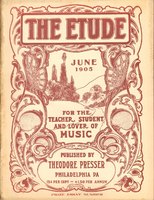H. K.—If you are desirous of writing for the large orchestra, you must have, in addition to thorough training in Harmony, Counterpoint, and Composition, a knowledge of the instruments of the orchestra, their characteristics, compasses, and effects in combination with other instruments. You can do but little in the matter of studying orchestration by yourself, unless you have an opportunity of hearing an orchestra play, and follow the score at the same time. Living as you do in a city that supports a first-class orchestra, we recommend that you study with a practical man who is connected with the orchestra, buy or rent scores of the works played, and attend every performance. If you content yourself with writing only in the ordinary pianoforte or vocal score, you cannot learn to write for the orchestra.
Teacher.—1. The tempo for the allegretto movement from Beethoven’s Sonata, Opus 14, No. 1, is given in a number of editions as dotted half note equals seventy-two. This means that the entire measure is to be played to one click of the metronome. You are correct in thinking this rather fast, but a certain flexibility of tempo must be taken into consideration, the metronome marking indicating the extreme speed at which any one measure is to be played. We prefer sixty-nine, or even sixty-six, to seventy-two for the movement.
2. The Andante from Schubert’s “Unfinished” Symphony in B minor is generally played at about, eighth note equals seventy-six. A good tempo for Mendelssohn’s “Spring Song” is quarter note equals ninety-two.
3. “Nel cor piu” is known in English as “Hope Told a Flattering Tale.” “Peer Gynt” is the name of the hero in the mystical drama by Ibsen, to which Grieg wrote incidental musical numbers. These various numbers were afterwards compiled into a “Suite” by the composer, and the solo and duet pianoforte arrangements have been made from the original orchestral score.
Subscriber.—1. The style of phrasing to which you refer, in which two slurs are joined together over a single note, is used to indicate both grammatical division and execution. That is to say, the joined slurs indicate the close of one phrase and the beginning of another upon the same note, a linking together of phrases, which is accomplished without raising the hands.
2. Two diatonic grace notes preceding a principal note constitute a mordent or an inverted mordent. Both these ornaments were formerly indicated by signs. The mordent begins with the principal note, goes to the note below and returns to the principal note. For instance: C-B-C (principal note). The inverted mordent begins with the principal note, goes to the note above and returns, thus: C-D-C (principal note). Neither of these ornaments is ever properly executed as a triplet. The first two notes are to be made very short. For instance, if the principal note is a quarter note, the two grace notes will be played as thirty-seconds and the quarter note be reduced to the value of a dotted eighth. The first of the two grace notes will be played exactly on the beat.
3. In the case of extended chords, as in the Schubert-Liszt “Hark! Hark! the Lark,” the arpeggio sign is generally used, although it would be impossible for ordinary hands to sound all the notes of the chord together in any event.
4. The crossing of the hands in the same piece is employed to gain additional sonority and varied tone color. Very often the thumbs are crossed for the same purposes.
A. F.—Although the law on the subject differs in various States, as a general rule, only chartered institutions may confer degrees. But this is quite a different matter from awarding diplomas, or certificates of graduation or of general proficiency. Such certificates may indeed be awarded by any private teacher and are largely in use among unchartered schools and other institutions. In order to confer degrees, a charter is necessary, granted by the proper State authorities or by the courts. Unfortunately, in some States this power has been much abused, charters having been granted insignificant institutions with incompetent faculties. The value of certain degrees is thus much weakened. Very few conservatories of music are in possession of charters and those which do have are rather chary about conferring degrees. Practically all such schools award diplomas or certificates. We would advise you, if you are about opening a school, to consult the laws of your own State upon the subject.



